Independent Building Surveyors
We are independent building Surveyors who carry out structural surveys on all types, styles and eras of buildings in all kinds of weather! We recently heard the weather forecast as we were driving to carry out a Structural Survey which made us wonder how much the weather affects our day to day life. It certainly affects how buildings perform, for example, the location of a house, possibly exposed on the top of a hill (as in our sketch) to in a valley hidden from the wind and rain but maybe more susceptible to frost.
Please call us on free phone 0800 298 5424 for a friendly chat on the weather or any property matters.
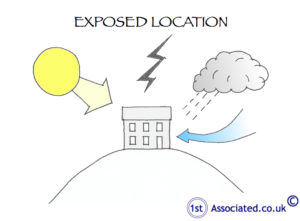
House exposed to weather
conditions on the top of the hill
Location, Location,Location
It is often said that when you buy a property such as your new house and home there are three things that are important to remember – location, location and location. The irony being that location far outweighs the importance of anything else.
We would also say this is true when it comes to the weather as your location certainly can affect how your building performs. For example we have come across considerable corrosion at seaside or holiday resorts where there is literally salt in the air.

Relatively new industrial building
has rusting caused by the salt in
the sea air
Heavy Rain!
Without wondering too much about what the difference is between heavy rain and light rain, after driving through a thunder storm past flooded fields either side of the dual carriageway to carry out a Structural Survey concerning problems on a roof, it does make you think about what all the rain is doing to our houses and homes.
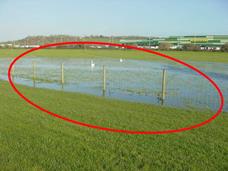
Flooding in fields.
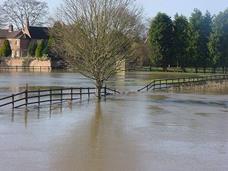
We hope any animals were safely
removed before the flood waters
from the nearby river submerged
these fields
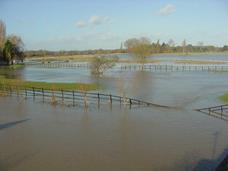
Flooded fields close to houses. What
damage does this do to them?
If we are talking about rain we do need to talk about roofs
Roofs can be divided into pitched roofs and flat roofs.
Pitched roofs
We are very big fans of pitched roofs. With the pitched roof there is everything from the traditional thatch since the year dot, clay tiles originally handmade and later machine made (again from the year dot). These are in the form of pantiles in the East Anglia area with small clay tiles being common in the south of England and also slates that were commonly used in the Victorian era.
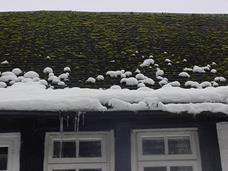
Moss on a pitched roof indicating
that the surface is likely to be
deteriorating
With the Industrial Revolution came the transport system which meant slates could be moved almost anywhere and so slate became the predominant roofing material. All of these roofs can suffer from wind driven rain.
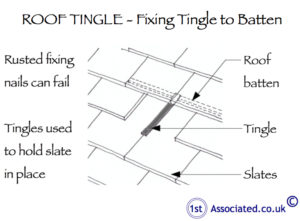
Roof tingle
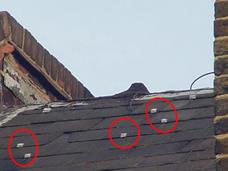
Lead tingles on a Victorian slate roof
Flat roofs
Even though there have been massive advances in flat roof technology we do tend to find there are problems. Once flat roofs were either felt or asphalt and it has to be said that the asphalt roofs have been excellent often giving a life of thirty plus years. The original felt roofs were very problematic.
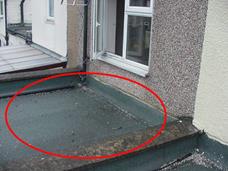
Mineral felt roof over a rear
extension
Modern flat roofs have moved on considerably with all sorts of technology including high performance felt with some being almost elastic in the way that they perform. Other types include glass re-enforced plastic and mono-ply roofs which are a single rubberised/plastic sheeted roof.
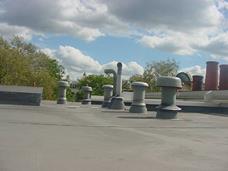
Mono-ply roof with vents on a
modernised Victorian
townhouse
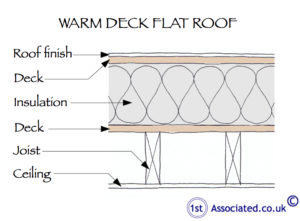
Warm deck flat roof
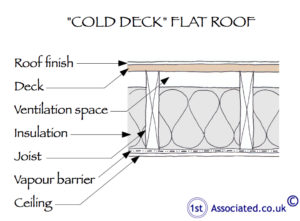
Cold deck flat roof
Rain getting in through the roof
The first thing that we would recommend if you do have problems with your roof is have a good look at it. We would use a zoom lens or binoculars to have a good close look at the roof. If it's a pitched roof you can often see where the rain is getting in.
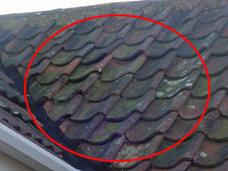
Leaking roof due to displaced tiles
In the adjacent photo the roof was leaking due to displaced tiles. Often displaced tiles or slates will be due to high winds dislodging the tiles or slates. You also need to look closely at the detailing such as the flashings and also the perimeter of the tiles or slates as these are vulnerable as again the wind can catch underneath them and result in water coming in
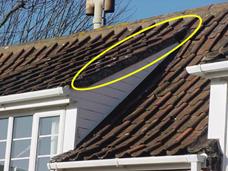
Problems can also occur at the
verge of the roof as well
Whatever the roof is made of you need to look at the detailing.
It's important to stop wind driven rain from getting in and to do this you need to have good detailing. We have mentioned already about the flashings and the perimeter of a roof allowing rainwater in but this can also come in via a parapet wall. We refer you to our articles on roofs.
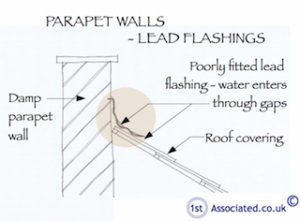
Water can also get in via a
parapet wall
What do the circles and ovals mean?
The circles and ovals are a system that we used within our structural surveys and building surveys to highlight property problem areas so that you are not left wondering what the problem is. In addition to this if the survey photographs do not explain the property problem enough, together with our survey report, we also add in survey sketches that have been created exclusively for our reports.
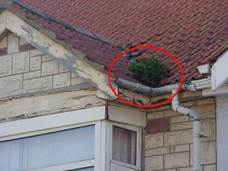
Blocked valley gutter
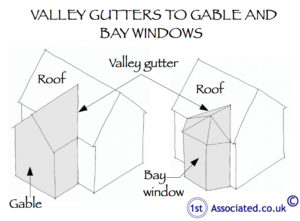
Valley gutters
Your roof leak may be a Gutter and Downpipe leak
It's always worth having a look around the main roof to see if your gutters and downpipes are taking the rainwater away. Better still is to stand outside next time it rains and see if the rainwater does go into the gutters or whether it misses them and also check to see if the downpipes do take the water away or if they are blocked.
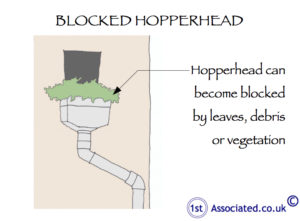
Blocked hopper head means the
down pipe cannot take the
rainwater away
What is the difference between heavy and light rain?
Joking apart many roofs do survive the relatively light rain during the spring, summer and autumn months but it is the heavier rain during the winter that causes the problems.
It is well worth at having a good look at the roofs or asking someone you trust to have a good look at your roof at the end of summer or the start of autumn to prepare yourself for the winter months.
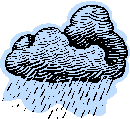
Prevailing Winds
In the UK the winds are generally south westerly or there may be local variations on this.
You may be interested in our surveying articles on:-
Not so common pitched roofs
Roofs and structural problems
Why you have never seen any building surveys or structural surveys like ours
Winter snow and ice and the problems it causes in your house
Flooding and thawing problems in houses
Should I have a structural survey?

Gales and storms and how they affect roofs
We can recall carrying out a survey on a roof of a property that had a number of problems and we had a builder/roofer accompany us to open up the roof to check its condition. The wind at the time of our survey was gathering pace and made it feel quite unsafe whilst we were viewing the roof.
You do need to be aware about windy conditions which can lift roof natural slates or manmade slates if not well secured. Windy conditions can also affect other sorts of roofs.
Roof tiles lifted by the wind
If you think of your house and home roof acting as a big sail you can imagine how it catches the wind and spills off the wind at ridge level (the top) meaning there is a pulling action by the wind on the side that does not face the wind which in itself can also cause damage.
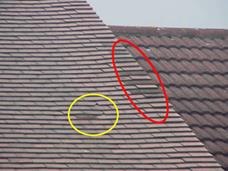
Roof tiles lifted by the wind
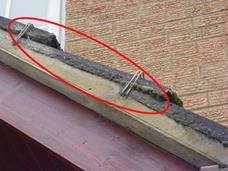
Tile clips on the edge of the roof
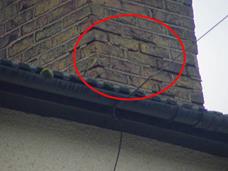
Weathered pointing on a chimney
caused by the wind
What does heavy rainfall do to the ground?
Ultimately a lot of rainfall leads to flooding particularly where there are rivers nearby, high water table levels or a sloping site which can lead to rainwater being tipped underneath your property causing dampness in walls and rot in suspended timber floors. If you have a concrete floor this can act effectively like blotting paper. Most people forget what is going on underneath the ground and underneath the floors in their buildings during a flood.
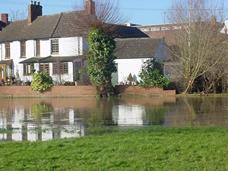
Flooded rivers can cause damp
problems in the floors of nearby
properties
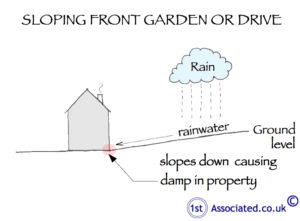
A sloping site can mean heavy rainfall can
cause dampness in a property
Flooding after the snow thaws
We have talked about the heavy rain and the gales now let us talk about flooding. Flooding can occur for a number of reasons. One of the common reasons is when snow and ice melts and this is an ever present problem during the winter months after a good downfall of snow. Snow can be particularly nice if it falls around Christmas but can have consequences of flooding after it thaws. With the thaw extra water is discharged into rivers which in some cases cannot cope and flooding occurs.

When snow thaws the extra water
causes rivers to flood

River has burst its banks
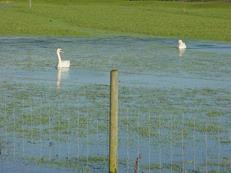
Flooding caused after snow fall has
thawed
Why have an Independent Building Survey, Caveat Emptor?
Caveat emptor means buyer beware and is why you need to have a Building Survey to find out if there are any problems such as dampness within the property especially if you are buying a property in a known flood area. An Independent Building Surveyor is working for you and not a bank or building society.
Our Good, Bad & Ugly surveys!
If you are buying a house or a home then we would like to introduce to you what we call our good, bad and ugly survey which is a Building Survey, sometimes known as a Structural Survey and which is tailor made to your requirements. Our Building Surveyors have listened to our customer feedback and also had market research carried out. We then designed a Building Survey that took over ten years to develop and it is written and explained in plain English making it easy to understand. As you can see from this article we also use a lot of photographs with circles and ovals to identify problems as well our sketches that we have had drawn specifically for our reports.
We can email you examples of our structural surveys and specific defect reports
If you are interested in having a Structural Survey or a Specific Defect Report on a roof or flooding problems on a property please call us on free phone us for a friendly chat on 0800 298 5424. We would be happy to email you several examples of our tailor made reports.
Surveying articles
We hope you found the article of use and if you have any experiences that you feel should be added to this article that would benefit others, or you feel that some of the information that we have put is wrong then please do not hesitate to contact us (we are only human).
The content of the website is for general information only and is not intended to be relied upon for specific or general decisions. Appropriate independent professional advice should be paid for before making such a decision. Free phone 1stAssociated.co.uk on 0800 298 5424
All rights reserved by 1stAssociated.co.uk
All rights are reserved the contents of the website are not to be reproduced or transmitted in any form in whole or part without the express written permission of www.1stAssociated.co.uk

